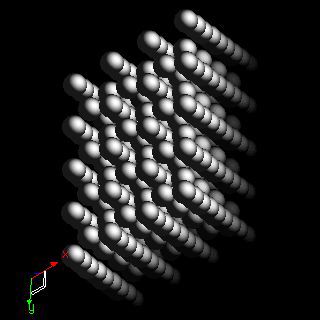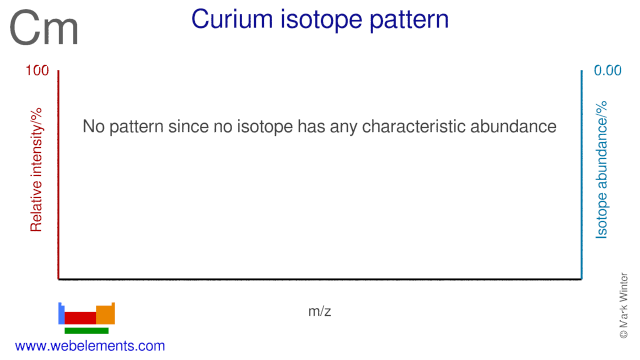Curium - 96Cm: the essentials
- Name: curium
- Symbol: Cm
- Atomic number: 96
- Relative atomic mass (Ar): [ 247 ] (longest lived isotope)
- Standard state: solid at 298 K
- Appearance: silver
- Classification: Metallic
- Group in periodic table:
- Group name: Actinoid
- Period in periodic table: 7 (actinoid)
- Block in periodic table: f
- Shell structure: 2.8.18.32.25.9.2
- CAS Registry: 7440-51-9
Curium atoms have 96 electrons and the shell structure is 2.8.18.32.25.9.2. The ground state electronic configuration of neutral curium is [Rn].5f7.6d1.7s2 and the term symbol of curium is 9D2.
Curium: description
Curium is a hard, brittle, radioactive silvery metal. It does not occur in nature and must be made in a nuclear reactor by neutron capture reactions from plutonium and americium isotopes. It tarnishes slowly in dry air at room temperature. Curium was first produced in 1944 at the University of California, Berkeley in the USA in a cyclotron by bombarding plutonium-239 (239Pu) with α-particles. It was isolated in visible quantities as the hydroxide, Cm(OH)3, in 1947.
Most compounds of Cm(III) are faintly yellow. If curium enters the body it accumulates in the bones, and is therefore very toxic as its radiation destroys the red-cell forming mechanism. Curium is a radioactive rare earth metal. The most stable isotope is 247Cm which has a half-life of 16 million years. Curium is probably present in uranium ores. It has a few specialised uses but only a few of its compounds are known.
Curium: physical properties
Density of solid: 13510 kg m-3
Molar volume: 18.05 cm3
Thermal conductivity: 10 (estimate) W m‑1 K‑1
Curium: heat properties
Melting point: 1613 [1340 °C (2444 °F)] K
Boiling point: 3383 [3110 °C (5630 °F)] K
Enthalpy of fusion: 20.5 kJ mol-1
Curium: atom sizes
Atomic radius (empirical): (no data) pm
Molecular single bond covalent radius: 166 (coordination number 3) ppm
van der Waals radius: (no data) ppm
Curium: electronegativities
Pauling electronegativity: 1.3 (Pauling units)
Allred Rochow electronegativity: 1.2 (Pauling units)
Mulliken-Jaffe electronegativity: (no data)
Curium: orbital properties
First ionisation energy: 578.08 kJ mol‑1
Second ionisation energy: 1200 kJ mol‑1
Third ionisation energy: 1940 kJ mol‑1
Curium: abundances
Universe: (no data) ppb by weight
Crustal rocks: (no data) ppb by weight
Human: (no data) ppb by weight
Curium: crystal structure

Curium: biological data
Human abundance by weight: (no data) ppb by weight
Curium has no biological role.
Curium: uses
Curium: reactions
Reactions of curium as the element with air, water, halogens, acids, and bases where known.
Curium: binary compounds
Binary compounds with halogens (known as halides), oxygen (known as oxides), hydrogen (known as hydrides), and other compounds of curium where known.
Curium: compound properties
Bond strengths; lattice energies of curium halides, hydrides, oxides (where known); and reduction potentials where known.
Curium: history
Curium was discovered by Glenn T. Seaborg, Ralph A. James, Albert Ghiorso in 1944 at USA. Origin of name: named after Pierre and Marie "Curie".Curium: isotopes

Curium: isolation
Isolation: coming soon!
